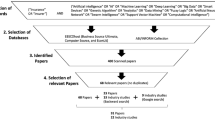Abstract
In this paper, we simulate several scenarios of the potential premium range for voluntary (supplementary) health insurance, covering benefits which might be excluded from mandatory health insurance (MI). Our findings show that, by adding risk-factors, the minimum premium decreases and the maximum increases. The magnitude of the premium range is especially substantial for benefits such as medical devices and drugs. When removing benefits from MI policymakers should be aware of the implications for the potential reduction of affordability of voluntary health insurance coverage in a competitive market.
Similar content being viewed by others
References
Armstrong, J., et al. (2004). Report to the South African Risk Equalization Fund Task Group. The International Review Panel, pp. 19–25.
Article 5(2) of the Council Directive 2004/113/EC of December 2004. Implementing the principle of equal treatment between men and women in the access to and supply of goods and services. http://eur-lex.europa.eu/LexUriServ/site/en/oj/2004/l_373/l_37320041221en00370043.pdf. Accessed 6 June 2006.
Article 13 of the EC Treaty, signed in Amsterdam in October 1997.
Buchmueller T.C., Feldstein P.J. (1997) The effect of price on switching among health plans. Journal of Health Economics, 16: 231–247. doi:10.1016/S0167-6296(96)00531-0
Colombo, F., & Tapay, N. (2004). Private health insurance in Ireland: A case study. OECD Health Working Paper, NO.10, DELSA/ELSA/WD/HEA.
Desmond K.A., Rice T., Fox P.D. (2006) Does grater Medicare HMO enrolment cause adverse selection into Medigap?. Health Economics, Policy and Law, 1: 3–21. doi:10.1017/S1744133105001039
Herring B., Pauly M.V. (2001) Premium variation in the individual health insurance market. International Journal of Health Care Finance and Economics, 1: 43–58. doi:10.1023/A:1011599905462
Lamers L.M., van Vliet R.C.J.A. (1996) Multiyear diagnostic information from prior hospital- izations as a risk-adjuster for capitation payments. Medical Care, 34(6): 549–561. doi:10.1097/00005650-199606000-00005
Newhouse J.P. (1996) Reimbursing health plans and health providers: Efficiency in production versus selection. Journal of Economic Literature, 34(3): 1236–1263
Organisation for Economic Co-operation and Development. (2004). Private health insurance in OECD countries. The OECD Health Project. OECD, 2004.
Paolucci, F. (2007). The design of basic and supplementary health care financing schemes: Implications for efficiency and affordability. Dissertation, Erasmus University Rotterdam.
Paolucci F., Schut E., Beck K., van de Voorde C., Greß S., Zmora I. (2007) Supplementary health insurance as a tool for risk-selection in mandatory basic health insurance markets: A five-country comparison. Health Economics, Policy and Law, 2: 173–192. doi:10.1017/S1744133107004124
Paolucci F., van de Ven W.P.M.M., den Exter A. (2006) Solidarity in competitive health insurance markets: Analysing the relevant EC legal framework. Health Economics, Policy and Law, 1(2): 107–126. doi:10.1017/S1744133105000137
Pauly M.V., Herring B. (2007) Risk pooling and regulation: Policy and reality in today’s individual health insurance market. Health Affairs, 26(3): 770–779. doi:10.1377/hlthaff.26.3.770
Pope G.C. et al (1999) Principal inpatient diagnostic cost group models for Medicare risk adjustment. Final Report to the Health Care Financing Administration. Health Economics Research, Inc., Waltham MA
Pope G.C. et al (2000) The principal inpatient diagnostic cost group model for Medicare risk adjustment. Health Care Financing Review, 21(3): 93–118
Prinsze F.J., van Vliet R.C.J.A. (2007) Health-based risk adjustment: Improving the pharmacy-based cost group model by adding diagnostic cost groups. Inquiry, 44: 469–480
Schut, E., Laske-Aldershof, T., & de Bruijn, D. (2004). Effecten van de aanvullende ziekenfondsverzekering op de hoofdverzekering: een theoretische en empirische analyse (Effects of supplementary sickness fund insurance on basic insurance: A theoretical and empirical analysis). Research memorandum for the Dutch Ministry of Health (VWS), Erasmus University Rotterdam.
Strombom B.A., Buchmueller T.C., Feldstein P.J. (2002) Switching costs, price sensitivity and health plan choice. Journal of Health Economics, 21: 89–116. doi:10.1016/S0167-6296(01)00124-2
Uccello, C. E., & Bertko, J. M. (2003). Medicare prescription drugs plans: the devil is in the details. http://www.actuary.org/pdf/medicare/drugbenefit_sept02.pdf. American Academy of Actuaries. Accessed 6 June 2006.
Van de Ven W.P.M.M., Ellis R.P. (2000) Risk adjustment in competitive health plan markets. In: Culyer A.J., Newhouse J.P. (Eds) Handbook of health economics. Elsevier, Amsterdam, pp 754–837
Van de Ven, W. P. M. M., & Schut, F. T. (2007). Risk equalization in an individual health insurance market: The only escape from the tradeoff between affordability, efficiency and selection: The Netherlands as a Case Study. http://www.fresh-thinking.org/docs/workshop_70503/PaperVandeVenSchut02apr07.pdf. Accessed 20 May 2007.
Van de Ven W.P.M.M. et al (2003) Risk adjustment and risk selection on the sickness fund insurance market in five European countries. Health Policy (Amsterdam), 65(1): 75–98. doi:10.1016/S0168-8510(02)00118-5
Van de Ven W.P.M.M. et al (2007) Risk adjustment and risk selection in Europe: 6 years later. Health Policy (Amsterdam), 83(2–3): 162–179. doi:10.1016/j.healthpol.2006.12.004
Van de Ven W.P.M.M., van Vliet R.C.J.A., Lamers L.M. (2004) Health-adjusted premium subsidies in the Netherlands. Health Affairs, 23(6): 45–55. doi:10.1377/hlthaff.23.3.45
Van de Ven W.P.M.M. et al (2000) Access to coverage for high-risks in a competitive individual health insurance market: Via premium rate restrictions or risk-adjusted premium subsidies?. Journal of Health Economics, 19(3): 311–339. doi:10.1016/S0167-6296(99)00028-4
Van Kolfschooten F. (2003) Dutch Government announces large cuts in health spending. Lancet, 362: 1048. doi:10.1016/S0140-6736(03)14453-4
Author information
Authors and Affiliations
Corresponding author
Rights and permissions
About this article
Cite this article
Paolucci, F., Prinsze, F., Stam, P.J.A. et al. The potential premium range of risk-rating in competitive markets for supplementary health insurance. Int J Health Care Finance Econ 9, 243–258 (2009). https://doi.org/10.1007/s10754-008-9049-8
Received:
Accepted:
Published:
Issue Date:
DOI: https://doi.org/10.1007/s10754-008-9049-8




